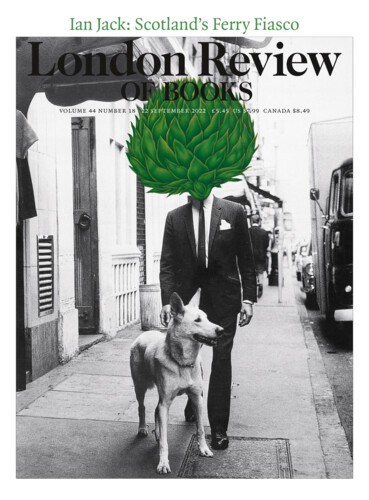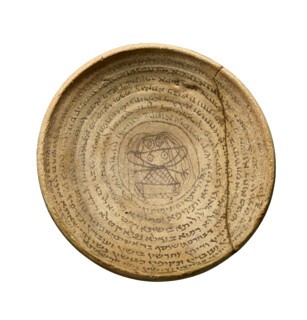The poster image for the British Museum’s Feminine Power exhibition (until 25 September) is a bronze sculpture, Lilith (1994), by the American artist Kiki Smith. Cast from the body of a real woman, this Lilith is a rich, dark bronze, with disarming, pale blue glass eyes. She is crouched on all fours, her head turned to one side, and positioned high up on the gallery wall. Her anatomy is deliberately hard to take in. Viewers must crane their necks to see her. She seems ready to pounce.
Lilith, or the lilith, is a figure from Mesopotamian and Jewish demonology. She – in early sources Lilith was sometimes male and sometimes described in the plural as well as the singular – was thought to kill babies, and to seduce and murder adults. In some traditions, she was responsible for miscarriage, infertility and illegitimate births. On display in the show are several incantation bowls against Lilith, made in what is now Iraq between 500 and 700 ce. They were buried upside down under the thresholds of houses to catch demons. One bowl, in a biscuity pale beige ceramic, is covered in circles of black text. At its centre is an image of Lilith in female form. She has long, wild hair, clearly outlined breasts and cartoon-swirls for eyes. She seems to be trying to struggle free from her shackles. The incantation, which begins at the centre and spirals outwards, addresses the ‘evil Lilith who leads astray the hearts of human beings’ and appears in ‘a dream of the night [and] a vision of the day … slaying boys and girls [and] sucklings, male and female – be subdued and sealed, [away] from the house and from the threshold of Bahrām-Gušnasp, son of Aštad Anahid’.
The name Bahrām-Gušnasp indicates that the householder was a Zoroastrian, but incantation bowls were also produced by late antique Jewish Babylonians. Their inscriptions indicate a belief that Lilith could become attached to human beings in a kind of demonic marriage, invading and perverting the domestic realm. The Talmud specifies that it is ‘forbidden to sleep in a house alone, and whoever sleeps in a house alone, a lilith seizes him’. (A reminder of how odd, even abhorrent, our modern habits of solitude would seem to our ancestors.)
From at least the late first millennium ce, the Jewish tradition understood Lilith as the first wife of Adam. The Alphabet of ben Sira, a satirical text from around 800 CE, says that Lilith was the first woman created by God. Unlike Eve, who was made from a spare rib, Lilith was made from the same clay as Adam. In Eden, Adam insisted that Lilith lie beneath him during sexual intercourse as an admission of her inferiority. She refused and fled Paradise. Adam complained to God, who sent three angels (angelic heavies, perhaps) to fetch her back; she refused. According to medieval tradition, she made her home in the Red Sea, where she gave birth to demons. This mother of demons was thought to be a threat to pregnant women. There is a long tradition, still practised today in some Jewish communities, of expectant mothers using birth amulets with prayers against Lilith to protect them in labour.
Lilith appears once in the Hebrew Bible (Isaiah 34:14), in a section describing the Day of Vengeance, when wild beasts will take over the earth. The lilith will meet with hyenas and wild goats in a landscape overrun by briars. Translating from the Hebrew in the early fifth century, St Jerome chose to replace ‘lilith’ with ‘lamia’, meaning ‘witch’ or ‘sorceress’ in Latin, but also – unhelpfully – a kind of flatfish and a species of owl. Later translators followed his lead, so Lilith is ‘the lamia’ in the Geneva Bible and a ‘screech owl’ in the King James Version. The New International Version has ‘night creature’, which is a pretty bland way to describe a murderous demon. Nowhere is she described as a flatfish, however.
The verse from Isaiah indicates that Lilith belongs to a wild place. To banish her from the home, the most powerful words must be used. A manuscript fragment from the store room of the Ben Ezra synagogue in Cairo – originating from a magical recipe book of c.1100 and structured as a get, or divorce contract – describes Lilith as a ‘raider demoness’ who ‘dwells in the house’ and is exhorted to go ‘to the field’. The tradition of issuing Lilith with a get descends from the Jewish Babylonian incantation bowls: ceramic and papyrus attest to a long-standing belief in the sacral power of words, especially written ones, to banish evil.
Jewish mysticism embroidered the legend of Lilith. In the 13th-century Spanish Treatise on the Left Emanation by Isaac ben Jacob ha-Kohen, Lilith is the wife of the demon archangel Samael, and the pair form a demonic counterpart to Adam and Eve. The text also mentions a daughter, Lilith the Maiden, ‘who is in the form of a beautiful woman from her head to her waist, and from the waist down she is burning fire’.
Lilith appears in European Christian literature of the 19th century, beginning with a scene in Goethe’s Faust (1808) in which Mephistopheles encourages Faust to dance with her. The episode intrigued artists. Richard Westall exhibited Faust and Lilith at the Royal Academy exhibition in 1831. His Lilith is a naked, milky-skinned babe, with rosy-red lips and pert breasts, her modesty obscured by a piece of white fabric. Faust, needless to say, is fully clothed – in Renaissance garb, complete with tunic, hose and feathered hat. We can only wonder what Bahrām-Gušnasp would have made of the image.
Lilith also fascinated the Pre-Raphaelites. In Dante Gabriel Rossetti’s Lady Lilith, she is an auburn-haired beauty admiring her image in a mirror, surrounded by roses and poppies. Rossetti wrote a sonnet to accompany the painting, where she is the ‘witch he [Adam] loved before the gift of Eve’, absorbed in her own reflection, admiring her ‘enchanted hair’, which can strangle youths caught in her spell. In his first version of the image (c.1868), Lilith had the face of his mistress, Fanny Cornforth, before she was painted over in favour of the model Alexa Wilding. It seems Lilith was cosmetically altered to suit the needs of Rossetti’s patron, Frederick Richards Leyland.
In John Collier’s Lilith (1887), the demon goddess is standing up, but her eyes are averted. There is none of the sense of threat posed by Kiki Smith’s sculpture. Here is a more demure Lilith, all milky skin and long, thick auburn hair. She wears nothing but a deftly draped serpent, which looks ready, at any moment, to slither away, revealing her nakedness. (Collier’s painting, like the Rossetti and the Westall, is absent from the BM show.)
More recently, Lilith has become a feminist icon. She has lent her name to a Jewish feminist magazine founded in the 1970s and a Canadian music festival for female solo artists and female-fronted bands. The Lilith Fund is the oldest abortion fund in Texas. A recent update on their website says they are ‘taking time to evaluate their operations’, but ‘are committed to our mission and accomplishing it through legal means’.
The complex, changing image of Lilith – from Mesopotamian and Jewish demon, bringer of miscarriage and sterility, to rebellious wife of Adam, to Victorian hottie and feminist icon – would have merited a small exhibition in itself. The same might be said for many of the other figures in the British Museum’s show, which adopts a broad-brush approach unlikely to satisfy anyone. Lilith gets rich treatment in the catalogue, but she is only a tiny part of an exhibition that has quarried artefacts from across the globe (and across the centuries) and placed them alongside one another with scant museum labels offering soundbites rather than exposition. ‘Women can be multifaceted’ reads one; ‘If you’re angry, harness that’ another; and even: ‘A woman can lift a car off her baby if necessary.’ The ebb and flow of feminine power over time and across cultures is, perhaps, more complicated.
Send Letters To:
The Editor
London Review of Books,
28 Little Russell Street
London, WC1A 2HN
letters@lrb.co.uk
Please include name, address, and a telephone number.


